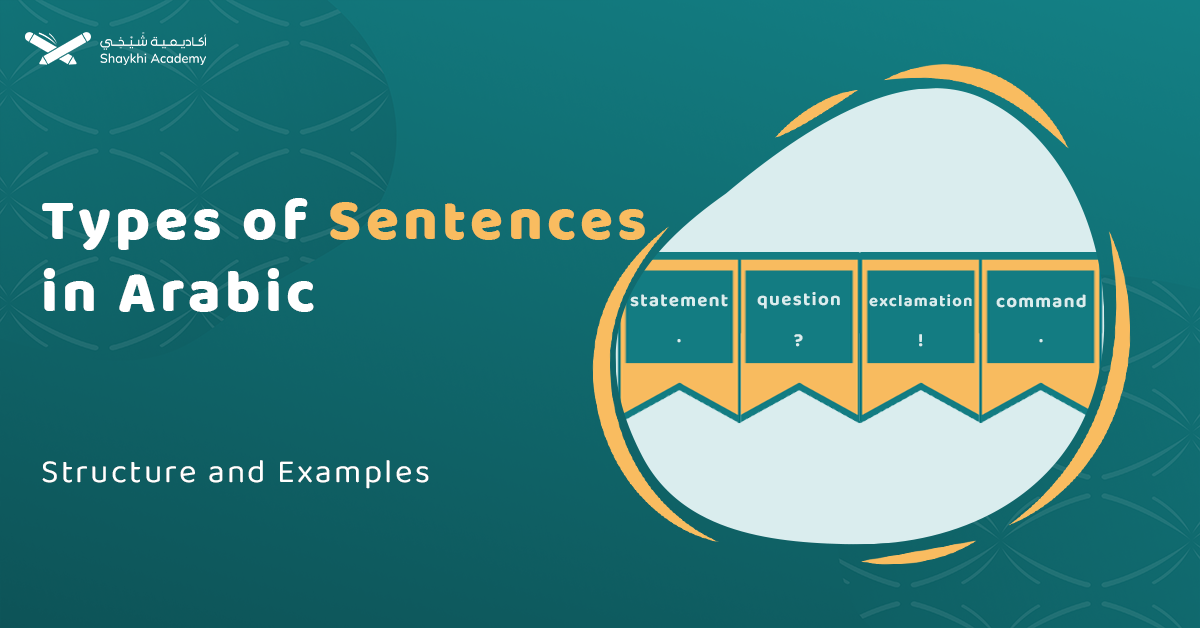Sentences in Arabic, as defined by Al-Zamakhshari, are the combination of two or more words that are connected to each other to form a useful and meaningful statement. There are two types of sentences in Arabic, nominal sentences and verbal sentences.
In this article, we will discuss in detail the types and structure of Arabic sentences, their components and rules, the difference between Arabic and English sentences, in addition to practical examples and useful exercises on this important topic.
Arabic Sentence Structure
Now, let us start with the Simple Sentence Structure in Arabic, its types, in addition to its components.
Types of Sentences in Arabic
Arabic sentences can be classified in many ways. According to sentence structure, Arabic sentences are classified into nominal and verbal sentences.
- The Nominal Sentence:
In Nominal sentences, the first word is a noun.
E.g: الكتاب جديد (The book is new)
- The Verbal Sentence:
In Verbal sentences, the first word is a verb.
E.g: دخل زيد البيت (Zaid entered the house).
Nominal Arabic Sentence Components
Arabic nominal sentences are mainly formed of two components, the subject (Al-mubtada – المُبتدَأ), and the predicate (Al-khabar – الْخَبَر). Let us briefly discuss each of them.
1. Subject (Al-mubtada – المُبتدَأ)
In Arabic Nominal sentences, the subject precedes the predicate. Usually, the subject of a nominal sentence is a definite noun. It is always in the nominative case (مَرْفُوع).
2. Predicate (Al-khabar – الْخَبَر)
The predicate completes the meaning of the sentence, it is in the nominative case, and is usually indefinite, and agrees in gender with the subject.
Verbal Arabic Sentence Components
Arabic verbal sentences are formed of a verb, a subject, and they may also contain an object.
A. The Verb (الفعل)
Arabic verbs are usually used at the beginning of the Arabic verbal sentence. They agree with the subject in number and gender. The Arabic verb has three different forms which are:
1. Past Tense:
The perfect tense is called madi ( المَاضي). It refers to an action which was finished at the indicated time, and is often denoting the past.
2. Imperfect Tense:
It is called mudare’ ( المُضَارِع), it denotes an incomplete action in either the present or the future time for that is either in progress or an action to be completed in the future.
3. The imperative form:
It is known as Al-amr (فِعلُ الأَمْر), it either refers to an order, a desire, a wish, or a supplication.
B. The Subject (الفاعل)
The subject of the Arabic verbal sentence follows the verb. It always agrees with the verb in terms of gender and number. It is in the nominative case and is usually marked by a dammah.
C. The Object (المفعول به)
In verbal sentences, the object usually follows the subject. It is often marked by an accusative case ending (usually a final fathah).
Arabic Compound and Complex Sentences
Arabic Complex or Compound sentences contain more than one predication. Let us briefly discuss the structure of each:
A. Compound Arabic Sentences (الجُمَل المُرَكَّبَة)
Arabic compound sentences contain clauses that are related by coordinating conjunctions such as (وَ – wa), (فَ – fa), or (بَل – bal – but rather).
Compound sentences in Arabic consist of “more than one simple sentence that are joined together by a conjunctive particle.
The wa is the most commonly used connective particle in the Arabic language. It is used to join words, phrases, clauses, as well as sentences.
Unlike the English (and), the Arabic conjunction particle (wa – وَ) is repeated before every word joined with the word before it, no matter how many words are listed.
However, the Arabic particle (wa – وَ) is not actually one but several particles, each serves a different function. It may be used as a coordinator or as an adverbial particle. It could also be used to express oaths or accompaniment as well as many other usages.
Example:
هو يقرأ كتابًا، ويكتب رسالة
He reads a book, and he writes a letter
Arabic coordinating conjunctions have little or no effect on the morphology or syntax of the following clause, however, they build up the contents of the sentence in an additive way.
B. Complex Arabic Sentences ( الجُمَل المُعَقَّدَة)
On the other hand, a complex sentence in the Arabic language, is the sentence in which one or more of the non-verbal components (subject, object, adverb, adjective) is filled by a clause which if brought out, makes a complete free-standing simple sentence.
In Arabic, there are four different types of dependent clauses. These are mentioned in the table below together with the particles used in each type:
| Type of Subordinate Clause | Particles Used |
| Nominal | anna – أَنَّan – أَنْin – إِنْlaw – لَوْma – مَا |
| Adjectival | Allathi- الذيallati – التيallathina – الذينallaa’y – اللائي |
| Adverbial | (1)Time Particles:mundhou – مُنْذُhatta – حَتَّىlamma – لَمَّاbadama – بَعْدَمَاindama – عِنْدَمَا (2) Purpose; Result and Reason Particles:li/li’anna – لِأَنَّli’alla – لِئلَّاhatta – حَتَّىli’anna – لِأَنَّkay – كَيْKayla – كَيلا (3) Concessive; Exceptive Particles:ma’a anna – مَعَ أَنَّbirragmi (min) anna – بالرَّغمِ مِنْ أَنَّala:rragmi (min) anna – عَلى الرغْمِ مِنْ أَنَّilla anna – إلَّا أنَّbayda anna – بيْدَ أَنَّgayra anna – غَيْرَ أنَّ |
| Conditional | In – إِنْIdha – إذَاLaw – لَوْ |
Example:
أحب الكتاب الذي قرأته
uhibbu al-kitaab al-ladhi qara’tahu
“I love the book that you read.”
Arabic subordinating conjunctions may have a grammatical effect on the structure of the following clause.
For example, anna and related particles
are followed by a clause whose subject is either a suffixed pronoun or a noun in the accusative; (likay) is followed by a verb in the subjunctive mood.
Word Order in Arabic Sentences
We mean by the Arabic Word Order, the arrangement of words within the sentence in order to express the meaning.
Unlike English, where the most common word order is subject, verb, object (SVO). In the Arabic language, we usually put the verb at the beginning of the sentence followed by the subject then the object.
For example:
| Type | Translation | Transliteration | Word |
| Verb | studies | Yudhakir | يُذاكِرُ |
| Subject | the student | At-tilmidth | التِّلْمِيذُ |
| Object | the lesson | Ad-dars | الدَّرْسَ |
So, in Arabic we usually say,
يُذَاكِرُ التِّلْمِيذُ الدَّرْسَ
However, in some contexts, we can start the sentence with the Subject (التَّلْمِيذ يُذاكِرُ الدَّرْسَ), or we can also start the sentence with the object (الدَّرْس يُذاكِرُ
ُ التَّلْمِيذ), with the purpose of putting more emphasis on the subject or the object.
Now, let us learn the order of words in different Arabic sentence forms:
Word Order in Arabic Questions
An interrogative particle can be added at the beginning of the Arabic sentence to form a question.
For example:
هل يُذَاكِر التلمِيذُ الدَّرْسَ؟
Hal yudhakiru at-tilmidhu ad-darsa?
Is the student studying the lesson?
Word Order with Arabic Adjectives
In Arabic, adjectives usually agree with the noun in the number and gender. Additionally, they maintain a Noun-Adjective order, unlike English.
For example:
زٓهْرٓةٌ جٓمِيلٓةٌ (zahratun jameelah): “A beautiful flower.”
مَسْجِدٌ كبير (Masjidun Kabir): “A big mosque.”
Word Order with Arabic Adverbs
Adverbs are usually placed at the end of Arabic sentences.
For example:
يجرِي اللاعِبُ بِسُرْعٓةٍ (Yaqra’ al-la’ibu bisur’a): “The player runs quickly.”
Word Order in Case of Negation
In Arabic, negating sentences is done by adding the particle لا (la) before the verb in the present tense and لم (lam) before the verb in the past tense, without any change in the order of the words in the sentence.
For example:
لا يلعب الطفل بالكرة (La yal’ab at-tiflu bil-korah): “The child does not play with the ball.”
لم يلعب الطفل بالكرة (Lam yal’ab at-tiflu bil-korah): “The child did not play with the ball.”
Read more about: Arabic Prepositions and Particles – الحُروف والظروف With Usage Examples
Arabic Sentence Structure vs English Sentence Structure
There are differences between the basic sentence structures of Arabic and English.
For instance, English has only verbal sentences. While Arabic has verbal and nominal sentences.
Nominal sentences in Arabic do not need verbs and are usually formed of two nouns only.
However, in English, a complete sentence contains a subject, a verb and an object.
Arabic has two different types of sentences: verbal sentences and nominal sentences. In a nominal sentence, you need a Subject (mubtada) and a predicate (khabar). Without the need to add a verb. They are often used to describe a thing or a person. On the other hand, the verbal sentence in Arabic has a verb, subject and an object.
Top 10 Sentences in Arabic
Now, let us learn some of the most commonly used Arabic sentences that might be useful for you in everyday conversations:
| Sentence | Transliteration | Translation |
| صَبَاحُ الْخَيرِ | Sabahul khair | Good morning. |
| كَيفَ حَالُكَ؟ | Kayfa haluka? | How are you? |
| أنا بخَيرٍ, شُكْرًا لكَ | Ana bikhair, shukran laka | I am fine, thank you. |
| مَا اسمُكَ؟ | Masmuka? | What is your name? |
| اسْمِي أحمد | Ismy Ahmed | My name is Ahmed. |
| مِنْ أيْنَ أنت؟ | Min ayna anta? | Where do you come from? |
| أَنَا لَا أَتَحَدَّثُ الْعَرَبِيَّة | Ana la atahaddathu al-arabiyyah | I don’t speak Arabic. |
| أُرِيدُ أن أذْهَبَ إلَى الْمَطَار | Uridu an adhaba ila al-matar | I want to go to the airport. |
| كَمْ سِعْر هَذِه الْحَقِيبَة | Kam si’r hadhihi al-haqeebah? | How much is this bag? |
| مَعَ السَّلَامَة | Ma’as-salamah | Goodbye. |
What are Arabic Equational Sentences?
Traditionally, Arabic grammar divides sentences into two main categories
depending on the first word in the sentence.
Sentences that start with a noun or noun phrase are termed (الْجُمْلَة الاسْمِيَّة – Al jumlah Al-ismiyya) or nominal sentences,
Whereas sentences starting with a verb are termed (الْجُمْلَة الفِعْلِيَّة – Al-jumlah Al-fi’liyah) or verbal sentences.
This first-word criterion is based on whether the verb is initial or not, and not on whether the sentence contains a verb or not.
However, in the teaching of Arabic as a foreign language, a different classification
is often used for Arabic sentences. This classification is based on whether or not the sentence contains a verb.
Hence, the English term “equational sentence” refers to verbless predications. While the term “verbal sentence” refers to predications containing a verb.
Abboud and McCarus mention that, “Arabic sentences are of two types, those with verbs, are called verbal sentences, and those not containing verbs, are called equational sentences” (emphasis in original; 1983, Part 1:102).
Confusion sometimes arises with the term “verbal sentence” because if one
uses it to refer to the traditional Arabic term, one means “sentence starting witha verb.” But if “verbal sentence” is used to refer to the distinction between verbless
and verb-containing sentences, it means “sentence containing a verb.”
Similarly, sometimes the terms jumla ismiyya and “equational sentence” are taken to be
equivalents, but they are not. A jumla ismiyya is a sentence that starts with a noun, including those that contain verbs.
An equational sentence refers to a predication that is specifically verbless.
Subject-Verb Agreement in Arabic
In Arabic, subject-verb agreement is important for forming sentences that are grammatically correct. When constructing Arabic sentences, you should note that the verb forms vary depending on the subject. Which means that the verb should agree with the subject in gender, number, and person.
Arabic Grammatical Cases
In Arabic grammar, a case system is used that indicates the grammatical function of words in the sentence. There are three main cases which are:
– Nominative Case (مرفوع):
It is usually indicated by a final dammah ( ُ ) or tanween dammh (ٌ ) , it is used for subjects as well as in nominal predicates.
– Accusative Case (منصوب):
It is usually Indicated by a final fathah (َ ) or tanween fath (ً ), it is used for direct objects.
– Genitive Case (مجرور):
It is usually Indicated by a final kasrah ( ِ ) or tanween kasr (ٍ ), it is used after prepositions and for indicating possession.
What is an easy way to turn a nominal sentence into a verbal sentence in Arabic?
You can easily turn a verbal sentence, which begins with a verb, into a nominal sentence (which begins with a noun) by putting a noun or an article at the beginning of the sentence, and vice versa.
For example:
In order to transform the nominal sentence (الكٌتَابُ ضاع -al-kitabu da’a- the book was lost), into a verbal sentence we shift the verb to the beginning of the sentence to become (ضَاعَ الْكِتَاب – da’a al-kitab).
Test Your Knowledge!
Now, it is time for you to practice! Mention the type of the following sentences, then change them from the nominal form to the verbal form and vice versa. Do not hesitate to send us your answers and get detailed feedback!
- ذَهَبَ الطبِيبُ إلَى المُسْتَشفَى.
- الْعِلْمُ يَنْفَعُ صَاحِبَه.
- الطَّالبَان يَكْتُبَان الدَّرْسَ.
- غَّرَّدَ الْعُصْفُورُ فَوْقَ الْغُصْنِ.
Master Arabic with Shaykhi Academy: Your Gateway to Fluency!
Are you eager to learn Arabic from the comfort of your home? Shaykhi Academy offers you the perfect opportunity to master Arabic, whether for Quranic studies, daily communication, or advanced understanding.
Why Shaykhi Academy?
- Expert Native Tutors: Learn from highly qualified native Arabic speakers.
- Flexible Scheduling: Tailor your classes to fit your busy life.
- Affordable Learning: Access top-quality education at a price that suits you.
- Global Access: Study from anywhere in the world.
Explore Our Arabic Courses:
- Noorani Qaida: Build a strong foundation in Quranic Arabic.
- Comprehensive Arabic Courses: Master the Arabic language, from beginner to advanced levels.
- Fusha Arabic Classes: Delve into Modern Standard Arabic, the key to understanding literature, media, and formal communication across the Arab world.
- Quranic Arabic Course: Enhance your connection with the Quran by learning the language in which it was revealed.
Start Your Arabic Journey Today! Whether you’re just starting or looking to deepen your knowledge, Shaykhi Academy is here to support your journey. Book your free trial now and begin your path to Arabic mastery!

To Sum Up!
In the Arabic language, sentences are either Nominal or Verbal sentences. The verbal sentence always begins with a verb. On the other hand, a nominal sentence consists of a nominal subject and (in the simplest instances) a nominal predicate and denotes bare being.
Join Shaykhi Academy now to learn more about Arabic grammar rules!

















































